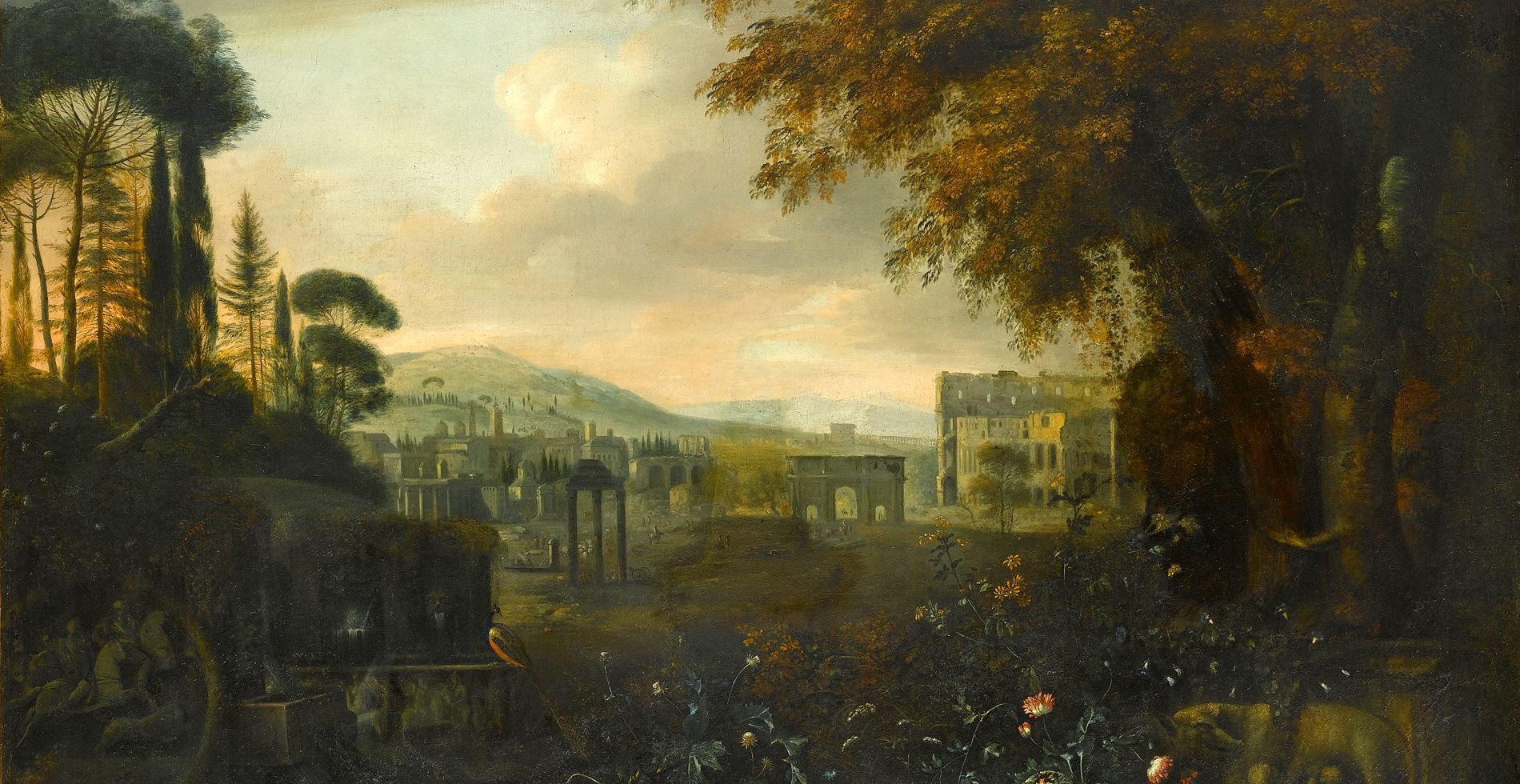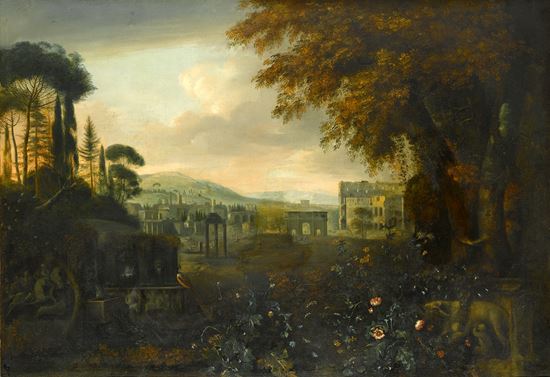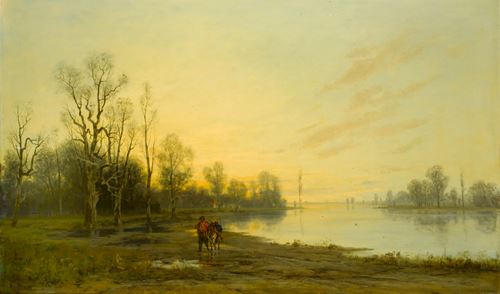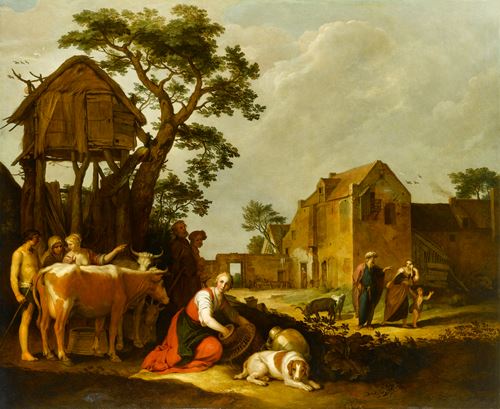atthias Withoos
(Amersfoort 1627 - Hoorn 1703)
Capriccio of the Forum, Rome, with the Arch of Constantine and the Coliseum in the Background
inscribed ‘No 120/Withoos/T/BE/_’ (on the reverse)
oil on canvas
98.1 x 135.4 cm (38⅝ x 53¼ in)
This enchanting scene by Matthias Withoos, Capriccio of the Forum, Rome, with the Arch of Constantine and the Coliseum in the Background, combines elements of Roman architecture with highly naturalistic depictions of trees and flowers. The painstaking detail with which the flowering bushes in the foreground of the painting are rendered is of particular note. Morning Glories, thistles and wild flowers, grow haphazardly around the base of a shady tree. A statue of Romulus and Remus as infants suckling from their wolf mother is nestled amongst the bushes. There are other statuary fragments scattered around the forest floor, such as a relief of a hunt with figures on horseback, and an ancient fountain, overgrown with moss and foliage, is situated at the base of a hill, from which Cyprus and Pine trees grow. A majestic peacock sits on the edge of the fountain, looking exotic and other worldly amongst the classical remains.
The background of the painting is equally full of interest, as figures can be made out exploring the ruins of Rome. The architecture, reflecting the remains of actual buildings, is superimposed with fanciful elements to form an imaginary cityscape. The Arch of Constantine is most prominent near the centre of the composition, while the Coliseum stands to the right. Cyprus trees are interspersed between the buildings and architectural fragments, giving them a stately and sombre tone. The predominance of cool colours, and the bluish hue pervading the entire painting, adds to its mysterious and melancholy air, as does the overcast sky and the corresponding shadiness on the ground.
The foreground section of the canvas, dominated by flowers, could constitute a painting in itself as it appears to stand apart from the rest of the composition. Withoos is best known for his still life paintings, such as Still Life in the Indianapolis Museum of Art, and it is evident that his foremost interest lies in the meticulous rendering of plants. In Still Life, cultivated flowers such as roses and lilies grow together with weeds and brambles forming a dense patch of foliage, under which a hedgehog, lizard and mouse find shelter. In Withoos’ still life paintings, the plants often have vanitas connotations; in Still Life, the roses and lilies symbolise the purity of the Virgin and the thistles and spiny plants represent Christ’s crown of thorns. The inclusion of the flowering plants in the present picture may have a similar purpose, with the morning glories being references to the transience of life, as they flower in the morning and die in the afternoon.
Withoos studied under Jacob van Campen and Otto Marseus van Schrieck. He accompanied van Schrieck and Willem van Aelst on a trip to Italy in 1648, where he became a member of the ‘Schildersbent’ in Rome. His patrons, while in Italy, included Cardinal Leopoldo de’ Medici. He had moved back to his birthplace, Amersfoort, by 1653 and lived there until 1672, when the French occupied the town, and subsequently resettled in Hoorn. In addition to still lifes, Withoos painted views of Dutch ports. Five of his children became painters, specialising in landscapes, still lifes and insect studies, in oil and watercolour.
We are grateful to Fred Meijer of the RKD, in the Hague, for confirming the attribution on the basis of a photograph.
W. Lindsay, Glasgow;
Christie's, London, 1859, lot 115, as Withoos (6 gns. to Mass).
This enchanting scene by Matthias Withoos, Capriccio of the Forum, Rome, with the Arch of Constantine and the Coliseum in the Background, combines elements of Roman architecture with highly naturalistic depictions of trees and flowers. The painstaking detail with which the flowering bushes in the foreground of the painting are rendered is of particular note. Morning Glories, thistles and wild flowers, grow haphazardly around the base of a shady tree. A statue of Romulus and Remus as infants suckling from their wolf mother is nestled amongst the bushes. There are other statuary fragments scattered around the forest floor, such as a relief of a hunt with figures on horseback, and an ancient fountain, overgrown with moss and foliage, is situated at the base of a hill, from which Cyprus and Pine trees grow. A majestic peacock sits on the edge of the fountain, looking exotic and other worldly amongst the classical remains.
The background of the painting is equally full of interest, as figures can be made out exploring the ruins of Rome. The architecture, reflecting the remains of actual buildings, is superimposed with fanciful elements to form an imaginary cityscape. The Arch of Constantine is most prominent near the centre of the composition, while the Coliseum stands to the right. Cyprus trees are interspersed between the buildings and architectural fragments, giving them a stately and sombre tone. The predominance of cool colours, and the bluish hue pervading the entire painting, adds to its mysterious and melancholy air, as does the overcast sky and the corresponding shadiness on the ground.
The foreground section of the canvas, dominated by flowers, could constitute a painting in itself as it appears to stand apart from the rest of the composition. Withoos is best known for his still life paintings, such as Still Life in the Indianapolis Museum of Art, and it is evident that his foremost interest lies in the meticulous rendering of plants. In Still Life, cultivated flowers such as roses and lilies grow together with weeds and brambles forming a dense patch of foliage, under which a hedgehog, lizard and mouse find shelter. In Withoos’ still life paintings, the plants often have vanitas connotations; in Still Life, the roses and lilies symbolise the purity of the Virgin and the thistles and spiny plants represent Christ’s crown of thorns. The inclusion of the flowering plants in the present picture may have a similar purpose, with the morning glories being references to the transience of life, as they flower in the morning and die in the afternoon.
Withoos studied under Jacob van Campen and Otto Marseus van Schrieck. He accompanied van Schrieck and Willem van Aelst on a trip to Italy in 1648, where he became a member of the ‘Schildersbent’ in Rome. His patrons, while in Italy, included Cardinal Leopoldo de’ Medici. He had moved back to his birthplace, Amersfoort, by 1653 and lived there until 1672, when the French occupied the town, and subsequently resettled in Hoorn. In addition to still lifes, Withoos painted views of Dutch ports. Five of his children became painters, specialising in landscapes, still lifes and insect studies, in oil and watercolour.
We are grateful to Fred Meijer of the RKD, in the Hague, for confirming the attribution on the basis of a photograph.
W. Lindsay, Glasgow;
Christie's, London, 1859, lot 115, as Withoos (6 gns. to Mass).





 contact
contact +44 20 7313 8040
+44 20 7313 8040









